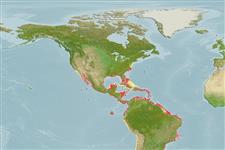>
Eupercaria/misc (Various families in series Eupercaria) >
Gerreidae (Mojarras)
Etymology: Eucinostomus: Greek, eu = good + Greek, kyon = dog + Greek, stoma = mouth (Ref. 45335).
More on authors: Baird & Girard.
Environment: milieu / climate zone / depth range / distribution range
Ecología
marino; agua dulce; salobre asociado a arrecife; rango de profundidad 0 - 12 m (Ref. 5227). Subtropical; 41°N - 30°S, 120°W - 34°W
Eastern Pacific: Anaheim Bay in southern California, USA southward to Peru, including the Galapagos Islands. Western Atlantic: New Jersey, USA and Bermuda through the Gulf of Mexico and the Caribbean to southeastern Brazil (Ref. 7251).
Length at first maturity / Tamaño / Peso / Age
Maturity: Lm 12.8 range ? - ? cm
Max length : 21.2 cm TL macho / no sexado; (Ref. 102462); common length : 15.0 cm TL macho / no sexado; (Ref. 3722); peso máximo publicado: 119.66 g (Ref. 102462)
Espinas dorsales (total): 9; Radios blandos dorsales (total): 10; Espinas anales 3; Radios blandos anales: 8. Tip of dorsal fin dusky. Premaxillary groove continuous but narrow, bordered by scales anteriorly (Ref. 26938).
Found over soft bottoms of bays and shallow inshore areas, often along sand beaches (Ref. 2850). Enters freshwater (Ref. 7251). Juveniles are encountered in lagoons of mangroves. Omnivorous (Ref. 9303). Marketed fresh but not highly esteemed; processed into fish meal and used as live bait in the snapper fishery (Ref. 3722).
Life cycle and mating behavior
Madurez | Reproducción | Puesta | Huevos | Fecundidad | Larva
Eschmeyer, W.N., E.S. Herald and H. Hammann, 1983. A field guide to Pacific coast fishes of North America. Boston (MA, USA): Houghton Mifflin Company. xii+336 p. (Ref. 2850)
IUCN Red List Status (Ref. 130435)
Threat to humans
Harmless
Human uses
Pesquerías: escaso valor comercial; carnada: occasionally
Más información
ReferenciasAcuiculturaPerfil de acuiculturaRazasGenéticaElectrophoresesheritabilidadEnfermedadesProcesamientoNutrientsMass conversion
ColaboradoresImágenesStamps, Coins Misc.SonidosCiguateraVelocidadTipo de nataciónSuperficie branquialOtolitosCerebrosVisión
Herramientas
Special reports
Download XML
Fuentes de Internet
Estimates based on models
Preferred temperature (Ref.
123201): 20.6 - 28.3, mean 27 °C (based on 1053 cells).
Phylogenetic diversity index (Ref.
82804): PD
50 = 0.5010 [Uniqueness, from 0.5 = low to 2.0 = high].
Bayesian length-weight: a=0.00977 (0.00825 - 0.01157), b=3.08 (3.04 - 3.12), in cm total length, based on LWR estimates for this species (Ref.
93245).
Nivel trófico (Ref.
69278): 3.2 ±0.1 se; based on diet studies.
Resiliencia (Ref.
120179): Alto, población duplicada en un tiempo mínimo inferior a 15 meses (Preliminary K or Fecundity.).
Fishing Vulnerability (Ref.
59153): Low to moderate vulnerability (25 of 100).
Nutrients (Ref.
124155): Calcium = 51.4 [19.0, 111.5] mg/100g; Iron = 0.642 [0.289, 1.253] mg/100g; Protein = 20.1 [18.1, 22.1] %; Omega3 = 0.216 [0.105, 0.433] g/100g; Selenium = 9.44 [4.21, 20.40] μg/100g; VitaminA = 54.2 [13.4, 206.5] μg/100g; Zinc = 1.2 [0.7, 1.9] mg/100g (wet weight);
